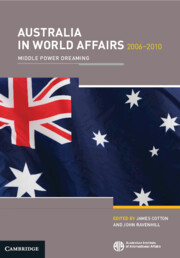Book contents
- Frontmatter
- Contents
- Tables, Figures and Boxes
- Contributors
- Preface
- Abbreviations
- 1 Middle Power Dreaming: Australian Foreign Policy during the Rudd–Gillard Governments
- 2 The Howard–Downer Legacy: Global Deputy, Regional Sheriff
- 3 Back from the Brink: Australia and the Global Economy 2006–10
- 4 Australia–America 2006–2010: Waiting for Obama
- 5 Australia and China: The Challenges to Forging a ‘True Friendship’
- 6 Australia and Japan: Mobilising the Bilateral Relationship
- 7 Australia and Europe
- 8 Australia’s Strategic and Commercial Engagement with South Asia under Kevin Rudd: The Paradoxes
- 9 Australia, the Pacific Islands and Timor-Leste
- 10 Progress and Limits in Regional Cooperation: Australia and Southeast Asia
- 11 Australian Foreign Policy towards Africa
- 12 Plus Ça Change? The Coalition, Labor and the Challenges of Environmental Foreign Policy
- 13 The Australia 2020 Summit as an Experiment in Foreign Policy-making
- 14 Defence and Security
- 15 Australia’s Foreign Policy Machinery
- 16 Regional, Alliance and Global Priorities of the Rudd–Gillard Governments
- References
- Index
9 - Australia, the Pacific Islands and Timor-Leste
Published online by Cambridge University Press: 04 May 2024
- Frontmatter
- Contents
- Tables, Figures and Boxes
- Contributors
- Preface
- Abbreviations
- 1 Middle Power Dreaming: Australian Foreign Policy during the Rudd–Gillard Governments
- 2 The Howard–Downer Legacy: Global Deputy, Regional Sheriff
- 3 Back from the Brink: Australia and the Global Economy 2006–10
- 4 Australia–America 2006–2010: Waiting for Obama
- 5 Australia and China: The Challenges to Forging a ‘True Friendship’
- 6 Australia and Japan: Mobilising the Bilateral Relationship
- 7 Australia and Europe
- 8 Australia’s Strategic and Commercial Engagement with South Asia under Kevin Rudd: The Paradoxes
- 9 Australia, the Pacific Islands and Timor-Leste
- 10 Progress and Limits in Regional Cooperation: Australia and Southeast Asia
- 11 Australian Foreign Policy towards Africa
- 12 Plus Ça Change? The Coalition, Labor and the Challenges of Environmental Foreign Policy
- 13 The Australia 2020 Summit as an Experiment in Foreign Policy-making
- 14 Defence and Security
- 15 Australia’s Foreign Policy Machinery
- 16 Regional, Alliance and Global Priorities of the Rudd–Gillard Governments
- References
- Index
Summary
Australia devotes more diplomatic energy to its relations with the South Pacific states and Timor-Leste than their modest populations might seem to justify. Only Papua New Guinea (PNG) (6.6 million) and Timor-Leste (1.1 million) have populations of more than one million, followed by Fiji (840 000) and Solomon Islands (518 000), with the rest easily qualifying as microstates. The total population of the South Pacific region and Timor-Leste (fewer than ten million) is dwarfed by that of their regional neighbour Indonesia (240 million). Australia became more closely involved with this region and expended more diplomatic resources on it between 2005 and 2010 than at any time since the Pacific Island states first became independent. Australian troops were in continuous deployment to Timor-Leste and Solomon Islands, and were briefly sent to Tonga. A coup in Fiji, the fourth in 20 years, created a nagging diplomatic problem for the Howard, Rudd and Gillard governments, which could not condone a Pacific dictatorship and yet sought to avoid a total breakdown in relations with a country of regional importance.
Keywords
- Type
- Chapter
- Information
- Australia in World Affairs 2006–2010Middle Power Dreaming, pp. 127 - 142Publisher: Cambridge University PressFirst published in: 2024



